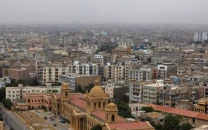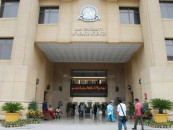Dr Asma Ibrahim tries to solve the ‘hole’ mystery by putting pieces of the puzzle together
Archaeologists have been unable to explain existence of curious holes in ceramic items excavated from Bhambore.

Dr Ibrahim also spoke about research conducted on the site and materials. PHOTO: FILE
She and her fellow archaeologists have been unable to explain the existence of curious holes in shards of a particular type of ceramic item that were excavated from the site in the 20th century. During her presentation titled ‘Talking shards’, Dr Ibrahim said that judging from the complexity of ceramic items that have been excavated, archaeologists agree that the region possessed a fairly skilled workforce.

But they have been unable to explain why some shards are punctured and even more curiously, why the holes exist only in pieces of one kind of ceramic objects. She guessed that since Bhambore was a trading point, perhaps punctured shards were used as some kind of currency in the past. Dr Ibrahim also spoke about research conducted on the site and materials, which has led some experts to believe that craftsmen in Bhambhore engaged in pottery and other artistic endeavors from 1 BCE to 12 CE. The items they produced were mostly used to store food and water, and for trading purposes. Some of them were also used as amulets or for other religious purposes.
 “Archaeologists, however, have yet to determine if the glazed ceramics found from the site were manufactured by the people of Bhambhore, or if they had been imported from the Middle East.” Dr Ibrahim devoted a part of her presentation to forms of pottery that were developed in Islamic empires. One of them, the Sgraffito, was developed by Muslim potters in the 10th century, said the curator. However, she added that it was clear that some forms of pottery were clearly influenced by their earlier Chinese counterparts. Coming back to explaining the “holes” that were only found in Sgraffito pieces, Dr Ibrahim also suggested that they might have been made by the residents of Bhambhore as they joined them with threads or wires.
“Archaeologists, however, have yet to determine if the glazed ceramics found from the site were manufactured by the people of Bhambhore, or if they had been imported from the Middle East.” Dr Ibrahim devoted a part of her presentation to forms of pottery that were developed in Islamic empires. One of them, the Sgraffito, was developed by Muslim potters in the 10th century, said the curator. However, she added that it was clear that some forms of pottery were clearly influenced by their earlier Chinese counterparts. Coming back to explaining the “holes” that were only found in Sgraffito pieces, Dr Ibrahim also suggested that they might have been made by the residents of Bhambhore as they joined them with threads or wires.Published in The Express Tribune, January 14th, 2013.


















COMMENTS
Comments are moderated and generally will be posted if they are on-topic and not abusive.
For more information, please see our Comments FAQ